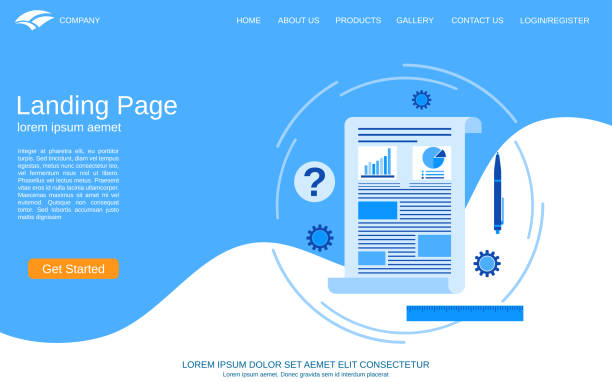An Introduction to Responsive Website Design and Its Importance

In today’s fast-paced technological world, #Responsive_Web_Design is no longer a luxury option, but an undeniable necessity for every business and website.
The concept of #Responsive_Web means a website’s ability to adapt itself to various screen dimensions of different devices, from desktop computers and laptops to tablets and smartphones.
This capability ensures that the #User_Experience is consistent, smooth, and enjoyable on any device.
Without responsive website design, users are forced to zoom or endure annoying horizontal scrolls to view content on smaller devices, which quickly leads to dissatisfaction and leaving the website.
Web design today must meet the needs of diverse audiences on various platforms.
Furthermore, from an SEO perspective, Google and other search engines give higher scores to websites with responsive design and display them higher in search results, as they believe these websites are #Mobile_Friendly and offer a better user experience.
Investing in responsive website design not only increases customer satisfaction but also significantly helps improve your search engine ranking and ultimately boosts your traffic and online success.
This approach is the foundation of any successful web strategy in the digital age, and ignoring it can result in losing a significant portion of your audience.
Therefore, understanding the principles and challenges of responsive website design is crucial for every developer and business owner.
Losing potential customers due to an unprofessional website? Rasawweb is your answer! With our specialized corporate website design services:
✅ Enhance your business’s credibility and standing
✅ Experience more targeted customer acquisition
⚡ Act now for a free consultation!
Challenges in Implementing Responsive Design

Implementing responsive website design, despite its numerous benefits, is not without challenges.
One of the biggest obstacles is managing the complexities associated with providing a suitable visual and functional experience across a wide range of screen sizes.
Developers must carefully define the layout, fonts, images, and interactive elements for each breakpoint, which can itself be a time-consuming and demanding process.
Furthermore, optimizing image and media loading for different devices is a significant challenge.
High-quality images suitable for desktop screens may lead to slow loading and high data consumption on mobiles.
Therefore, using techniques like srcset and lazy loading is crucial for website performance optimization.
In addition, there are performance challenges; sometimes, improper implementation of responsive website design can lead to extra coding and increased file size, negatively impacting website loading speed.
Testing and debugging are also vital parts of this process, requiring specialized tools and knowledge to ensure the website functions correctly across all devices and browsers.
Adapting navigation and menus for small screens is also an art that must be done without sacrificing accessibility and usability.
These points indicate that while responsive website design is a golden standard, its successful implementation requires a comprehensive approach, deep technical knowledge, and attention to detail.
Many projects face difficulties at this stage, as unexpected complexities arise, requiring more time and resources to achieve an optimal final product.
Key Principles in Responsive Website Design

Responsive website design is based on three fundamental principles: Fluid Grids, Flexible Images, and Media Queries.
Fluid Grids mean that the website layout is built using percentages and relative units like em or rem, rather than fixed pixels.
This approach allows website elements to automatically scale and adjust with changes in screen size.
For example, instead of setting a column width to 200 pixels, you set it to 20% of the total page width.
Flexible Images allow the website to display images appropriate to the user’s device screen size.
This is achieved using CSS properties like max-width: 100% which ensures the image never overflows its parent container and automatically scales down or up.
For further optimization, the srcset attribute in HTML5 can be used to provide images with different resolutions for various devices.
Finally, Media Queries are the core, magical element of responsive website design.
These CSS commands allow developers to apply different styles based on device characteristics such as screen width, resolution, orientation (portrait or landscape), and even device type.
For instance, you can specify that on screens smaller than 768 pixels, the navigation menu transforms into a hamburger icon, and on larger screens, it displays fully.
These principles together form the backbone of a successful responsive website, and any responsive website design without considering these elements would be incomplete.
These three principles are key to providing a consistent and optimized experience for the end-user.
Key Principles of Responsive Design and Their Application
| Key Principle | Description | Main Application |
|---|---|---|
| Fluid Grids | Using relative units (percentage, em, rem) instead of fixed pixels for layout. | Automatic layout adaptation to different screen dimensions. |
| Flexible Images | Scaling images based on available space using CSS and HTML5 (srcset). | Optimizing image display and loading on various devices. |
| Media Queries | Applying specific CSS styles based on device characteristics (e.g., screen width). | Changing appearance and layout based on screen size. |
Impact of Responsive Design on SEO and User Experience

Responsive website design not only improves your website’s appearance but also has a significant impact on Search Engine Optimization (SEO) and User Experience (UX).
From an SEO perspective, Google officially announced in 2015 that mobile-friendliness is a crucial ranking factor.
Websites that are properly responsive are preferred by Google and rank higher in mobile search results.
This means increased visibility, traffic, and ultimately, more customers.
A responsive website design eliminates the need to maintain two separate versions of the website (one for desktop and one for mobile), which helps reduce maintenance errors, improve indexing speed, and prevent duplicate content issues.
In terms of user experience, the impact of responsive website design is even more pronounced.
Today’s users access the internet from various devices and expect websites to be easily usable at any size.
A responsive website ensures that no matter what device the user is on, the content is displayed correctly, and navigation features are optimized.
This leads to a reduced bounce rate, increased user time on site, and ultimately, greater customer satisfaction and loyalty.
When users can easily find the information they need and interact with your website, their likelihood of returning and performing desired actions (such as purchasing, signing up, or contacting) significantly increases.
In summary, responsive website design is a crucial investment for long-term online success.
Did you know that 94% of a company’s first impression is related to its website design?
Rasawweb helps you create the best first impression by providing professional corporate website design services.
✅ Create a professional and trustworthy brand image for your brand
✅ Easier attraction of potential customers and improved online standing
⚡ Get a free corporate website design consultation
Popular Tools and Frameworks for Responsive Design

To facilitate the responsive website design process, developers can use a wide range of tools and frameworks that make coding simpler and faster.
One of the most well-known and widely used frameworks is Bootstrap.
Bootstrap is a CSS, HTML, and JavaScript framework that includes design templates for typography, forms, buttons, tables, navigations, and other UI components, helping developers quickly build responsive websites.
Tailwind CSS is another popular framework that takes a different approach.
Instead of providing ready-made components, Tailwind offers a set of low-level (utility-first) CSS classes that allow developers to build custom and responsive designs by combining these classes.
This approach provides very high flexibility but might be slightly more challenging for beginners.
In addition to these frameworks, Foundation and Bulma are other powerful options that offer similar capabilities for building responsive websites.
Tools like Flexbox and CSS Grid, which are part of CSS itself, also play a crucial role in modern responsive website design.
Flexbox is very powerful for one-dimensional layouts, and Grid for two-dimensional layouts, enabling developers to have precise control over how elements are displayed across different screen sizes.
Choosing the right framework or tool depends on project needs, team skills, and personal preferences.
However, using these tools certainly makes the responsive website design process more efficient.
The Future of Responsive Website Design with Emerging Technologies

The future of responsive website design is inextricably linked with the emergence of new technologies.
With the rapid advancements in artificial intelligence, machine learning, and augmented/virtual reality, it is expected that our interaction with websites and applications will undergo fundamental changes.
One important trend is the use of Progressive Web Apps (PWAs), which combine the best features of websites and mobile applications.
PWAs can work offline, send notifications, and have their icon placed on the device’s home screen, while still maintaining the responsive and accessible nature of the web.
Accelerated Mobile Pages (AMP) is also an approach for delivering high-speed web content on mobile devices, promoted by Google.
Although AMP has design limitations, it is a quick solution for responsive website design and an optimized mobile experience for news and blog-centric websites.
Furthermore, newer CSS technologies like Container Queries and Cascade Layers give developers more control over element responsiveness at different levels.
Container Queries, instead of responding to the overall viewport, react to the size of their parent container, providing unprecedented flexibility in responsive website design.
These advancements indicate that responsive website design is moving towards greater intelligence and flexibility, where websites will adapt not only to screen size but also to the device, environment, and even user behavior.
This vision promises an exciting future for the web and how we interact with it.
Case Study: Successful Examples of Responsive Design

To better understand the effectiveness of responsive website design, examining successful examples can be very insightful.
Many leading global companies have designed their websites using responsive principles to ensure users have the best experience on any device.
One of the most prominent examples is Airbnb’s website.
Airbnb is an accommodation booking platform and needs to provide a seamless user experience across various devices, from desktop to mobile.
Their website scales beautifully across different screen sizes, navigation intelligently adapts, and booking forms are easily usable on mobile.
This approach has helped Airbnb become one of the most successful online booking platforms.
Another example is The Boston Globe’s website.
This news website was one of the first major media outlets to fully adopt responsive website design.
Their goal was to deliver news in the best possible way to their audience, regardless of the device.
Their design, with flexible images and grid-based layouts, provides an enjoyable reading experience at any size.
Even Google’s website itself is a prime example of responsive website design.
Google’s search engine and its ancillary products are designed to perform flawlessly on any device, from the smallest smartphones to the largest monitors.
This adaptability is one of the main reasons for Google’s dominance in the search market.
These examples demonstrate that responsive website design is a practical and powerful solution for reaching a wide audience and providing an excellent user experience across the digital ecosystem.
Successful Examples of Responsive Design
| Website | Industry | Key Responsive Feature |
|---|---|---|
| Airbnb | Accommodation Booking | Smart navigation, optimized mobile forms, seamless booking experience. |
| The Boston Globe | News and Media | Flexible news layout, scalable images for reading experience. |
| Search Engine and Web Services | Simple and functional UI at any screen size, high accessibility. |
How to Determine if Your Website Needs Responsive Design?

This is a crucial question for every website owner.
The short answer is: “Almost every website!”
However, if you are still in doubt whether responsive website design is essential for you, there are several signs and criteria you can check.
The first and most important sign is mobile visitor statistics.
Analytics tools like Google Analytics can show you what percentage of your website traffic comes from mobile devices and tablets.
If this percentage is significant (which for most websites today is above 50%), then the need for responsive website design is urgent.
The second sign is a high Bounce Rate on mobile devices.
If mobile users quickly leave your website, this could be a clear indication that your website is not properly displayed or usable on smaller devices.
Also, if Google’s Mobile-Friendly Test tool identifies your website as “non-mobile-friendly,” this is a serious warning that will negatively affect your SEO and ranking.
Furthermore, if your competitors have responsive websites and you don’t, you are likely losing potential customers to them.
Customer satisfaction and retention are also key factors.
If your customers are complaining about your website experience on mobile through social media or direct feedback, this is a red flag.
Overall, in today’s mobile-first world, responsive website design is an essential investment to maintain competitiveness and provide the best user experience.
Ignoring this can cost you a significant portion of your market.
Did you know that 94% of customers’ first impression of your company comes from your website? With a powerful corporate website from Rasawweb, multiply your business’s credibility!
✅ Custom and eye-catching design tailored to your brand
✅ Improved user experience and increased attraction of potential customers
⚡ Get a free corporate website design consultation!
Advanced Tips and Optimization in Responsive Website Design

After implementing the basic principles of responsive website design, it’s time for advanced tips and optimizations to ensure your website is at its peak in terms of performance and user experience.
One such tip is adaptive image optimization.
Instead of simply scaling large images, you can use more advanced techniques like “Art Direction” which allows you to serve completely different images for different screen sizes, ensuring the best visual composition on any device.
Lazy Loading is also a crucial technique for improving loading speed, especially on mobile devices.
With lazy loading, images and videos are only loaded when the user scrolls to them and they enter the viewport.
This reduces initial loading time and saves user data.
Another tip is optimizing responsive fonts and typography.
Ensure that font sizes and line heights are readable and comfortable across different screen sizes.
Using relative units like vw (viewport width) for fonts can help with this.
Also, optimizing CSS and JavaScript performance for mobile is very important.
Using minified CSS and JavaScript and file compression (gzip compression) can significantly improve your website’s speed.
Additionally, Critical CSS (only loading CSS required for the above-the-fold content) can help improve the initial user experience.
Finally, continuous testing and performance monitoring of the website after launch, using analytics tools and speed measurement tools, is essential to identify and address any performance issues that may arise over time.
Responsive website design is not a static process, but a dynamic one that requires continuous testing, feedback, and optimization to provide the best user experience.
The Importance of Testing and Feedback in Responsive Design

Testing and feedback are vital elements in the lifecycle of responsive website design.
Simply coding a website using responsive principles is not enough; one must continuously ensure that the website functions correctly across a wide range of devices, browsers, and even different internet speeds.
Manual testing on physical devices, from smartphones to tablets and desktops, is essential.
This helps you identify display, performance, and interaction issues that might be overlooked in simulators or browser developer tools.
In addition to manual testing, using online responsive testing tools is also very beneficial.
Tools like “Responsive Design Checker” or the “Developer Tools” features in browsers (such as Chrome DevTools) allow you to quickly and easily simulate how your website looks at different screen sizes.
These tools are very efficient for checking breakpoints and ensuring layout correctness.
Beyond technical testing, gathering feedback from real users is crucial.
End-users, with their diverse experiences, can provide insights that developers might not have considered.
This feedback can be collected through surveys, user tests, or even direct comments on social media.
Feedback can help you identify parts of your responsive website design that are confusing or inefficient and need improvement.
Finally, continuous performance monitoring of the website after launch, using analytical tools and speed measurement tools, helps you identify and resolve any performance issues that may appear over time.
Responsive website design is not a static process, but a dynamic one that requires continuous testing, feedback, and optimization to provide the best user experience.
Frequently Asked Questions
| Question | Answer |
|---|---|
| What is responsive website design? | Responsive Web Design is an approach that causes the design and layout of a website to change and display optimally based on the user’s device screen size (computer, tablet, mobile, etc.). |
| Why is responsive design important? | Its importance is due to the increased use of various devices to access the internet. Responsive design improves User Experience (UX), reduces Bounce Rate, and is also beneficial for SEO. |
| What techniques are used in responsive design? | The main techniques include using Fluid Grids, Flexible Images, and Media Queries in CSS. |
| What does Fluid Grids mean? | Instead of using fixed pixel units, relative units like percentages or ems are used to define the width and height of elements, so that the layout is flexible with changes in screen size. |
| What is the application of Media Queries? | Media Queries allow you to apply different CSS styles based on user device characteristics such as screen width, height, orientation (horizontal or vertical), and resolution. |
And other services of Rasaweb Advertising Agency in the field of advertising
Smart Sales Automation: A combination of creativity and technology to increase click-through rates through SEO-driven content strategy.
Smart Digital Advertising: A creative platform to improve website traffic increase with intelligent data analysis.
Smart Digital Branding: A combination of creativity and technology to increase click-through rates by customizing user experience.
Smart SEO: A combination of creativity and technology for campaign management through Google Ads management.
Smart Google Ads: Designed for businesses looking to increase click-through rates through optimizing key pages.
And over hundreds of other services in the field of internet advertising, advertising consultation, and organizational solutions
Internet Advertising | Advertising Strategy | Advertorial
Resources
Principles of Responsive Web DesignWhy is Responsive Design Important for the Future of the Web?The Future of Web Design with Responsive ApproachesComprehensive Guide to Responsive Website Design
? With Rasawweb Afarin, the future of your business in the digital world is guaranteed! With our expertise in providing comprehensive digital marketing solutions, including corporate website design and advanced SEO strategies, we transform your online presence and accompany you on the path of sustainable growth and success.
📍 Tehran, Mirdamad Street, next to Bank Markazi, Kazeroun Jonoubi Alley, Ramin Alley, No. 6




